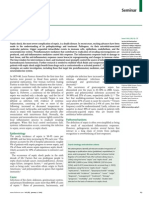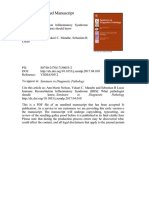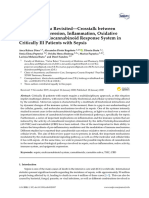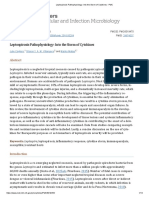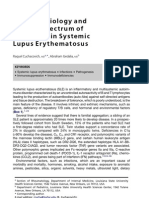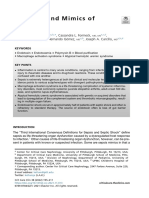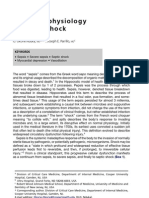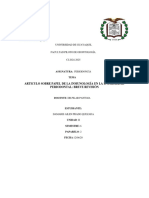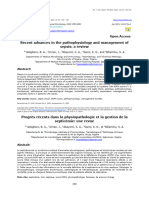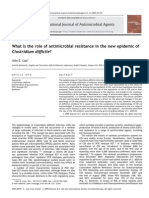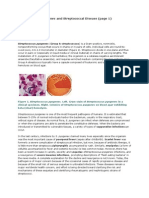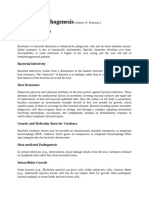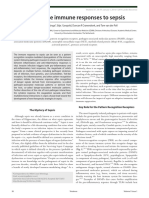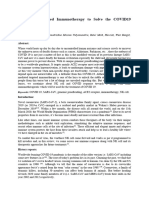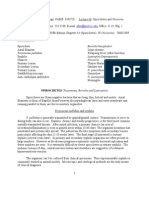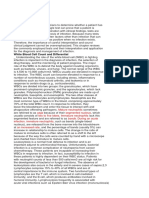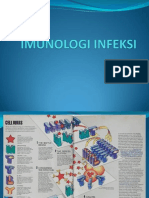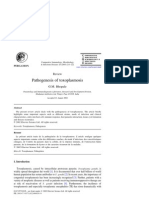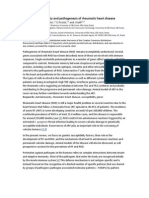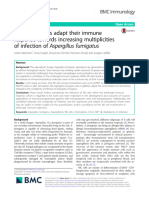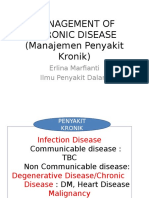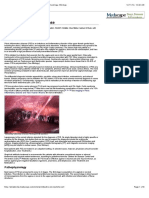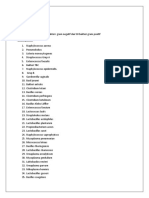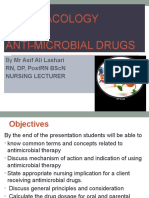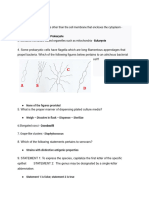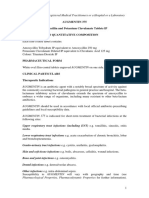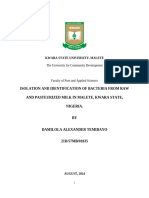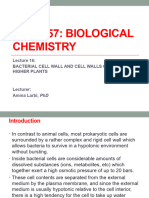Of Sepsis: New Concepts and Implications For Science, Medicine, and The Future: Pathogenesis
Of Sepsis: New Concepts and Implications For Science, Medicine, and The Future: Pathogenesis
Uploaded by
Andyan Adlu PrasetyajiCopyright:
Available Formats
Of Sepsis: New Concepts and Implications For Science, Medicine, and The Future: Pathogenesis
Of Sepsis: New Concepts and Implications For Science, Medicine, and The Future: Pathogenesis
Uploaded by
Andyan Adlu PrasetyajiOriginal Title
Copyright
Available Formats
Share this document
Did you find this document useful?
Is this content inappropriate?
Copyright:
Available Formats
Of Sepsis: New Concepts and Implications For Science, Medicine, and The Future: Pathogenesis
Of Sepsis: New Concepts and Implications For Science, Medicine, and The Future: Pathogenesis
Uploaded by
Andyan Adlu PrasetyajiCopyright:
Available Formats
Downloaded from bmj.
com on 12 September 2008
Science, medicine, and the future: Pathogenesis
of sepsis: new concepts and implications for
future treatment
Pierre-Yves Bochud and Thierry Calandra
BMJ 2003;326;262-266
doi:10.1136/bmj.326.7383.262
Updated information and services can be found at:
http://bmj.com/cgi/content/full/326/7383/262
These include:
Data supplement
References
"Further details"
http://bmj.com/cgi/content/full/326/7383/262/DC1
This article cites 27 articles, 10 of which can be accessed free at:
http://bmj.com/cgi/content/full/326/7383/262#BIBL
15 online articles that cite this article can be accessed at:
http://bmj.com/cgi/content/full/326/7383/262#otherarticles
Rapid responses
2 rapid responses have been posted to this article, which you can access for free
at:
http://bmj.com/cgi/content/full/326/7383/262#responses
You can respond to this article at:
http://bmj.com/cgi/eletter-submit/326/7383/262
Email alerting
service
Receive free email alerts when new articles cite this article - sign up in the box at
the top left of the article
Notes
To order reprints follow the "Request Permissions" link in the navigation box
To subscribe to BMJ go to:
http://resources.bmj.com/bmj/subscribers
Downloaded from bmj.com on 12 September 2008
Clinical review
Science, medicine, and the future
Pathogenesis of sepsis: new concepts and implications for
future treatment
Pierre-Yves Bochud, Thierry Calandra
Institute for
Systems Biology,
1441 North 34th
Street, Seattle, WA
98103-8904, USA
Pierre-Yves Bochud
research fellow
Division of
Infectious Diseases,
Centre Hospitalier
Universitaire
Vaudois, CH-1011
Lausanne,
Switzerland
Thierry Calandra
associate professor
Correspondence to:
T Calandra
Thierry.Calandra@
chuv.hospvd.ch
BMJ 2003;326:2626
Severe sepsis and septic shock are important causes of
death in intensive care units. Although our understanding of the pathogenesis of inflammation and sepsis has improved, until recently this has not translated
into clinical benefit. Several new treatment approaches
have given encouraging results. Evidence suggests that
the way forward is to develop pathogen specific
regimens rather than assume that one treatment fits all.
Sources and methods
We selected articles for this review by searching
Medline using the keywords sepsis, therapy, and
Toll-like receptors. We concentrated on publications
on the pathogenesis of sepsis and treatment of septic
shock. As the number of references that could be cited
was limited, we have often referenced review articles
rather than original publications.
Epidemiology and importance of severe
sepsis and septic shock
Further details
about pattern
recognition
receptors and
genetic
susceptibility are
available on
bmj.com
262
Severe sepsis and septic shock are life threatening
complications of infections and the most common
cause of death in intensive care units. However, a lack
of widely accepted definitions of these complications
has made it difficult to obtain accurate estimates of
their frequency. A study published by the Centers for
Disease Control in the United States indicated that the
incidence of septicaemia had increased from 73.6 per
100 000 patients in 1979 to 175.9 per 100 000 patients
in 1987.1 Recent US and European surveys have
estimated that severe sepsis accounts for 2-11% of all
admissions to hospital or intensive care units.2
Although Gram negative infections were predominant in the 1960s and early 1970s, Gram positive infections have increased in the past two decades and now
account for about half of cases of severe sepsis.3 Fungal
infections are also increasing in many countries. Despite
better supportive care, the hospital mortality from
severe sepsis and septic shock (30% and over 60%,
respectively) has not changed much over recent decades.
Innate immune responses to microbial
products
The innate immune system is the first line of defence
against infection and is activated when a pathogen
Summary points
Bacterial cell walls, endotoxins, and exotoxins are
powerful activators of innate and acquired
immune responses
Molecules expressed by pathogens interact with
Toll-like receptors on immune cells, activating the
immune response
Cytokines are important in the pathogenesis of
sepsis
Susceptibility to sepsis may be due to inherited or
acquired mutations of innate immune genes
Severe sepsis and septic shock are clinical
manifestations of a dysregulated immune
response to invasive pathogens
Adjunctive therapy with low dose steroids,
activated protein C or early supportive care can
reduce mortality from severe sepsis and septic
shock
Pathogen recognition receptors (such as Toll-like
receptors) and mediators of sepsis (such as
macrophage migration inhibitory factor) might
be novel targets for treatment
crosses the hosts natural defence barriers.4 It consists
of soluble elements (the alternative and mannanbinding lectin pathways of the complement system,
acute phase proteins, and cytokines) and cellular
elements (monocytes, macrophages, neutrophils, dendritic cells, and natural killer cells). Innate immune
responses must be tightly regulated as unbalanced
inflammatory and immune reactions can result in
either uncontrolled microbial growth or devastating
inflammatory responses with tissue injury, vascular collapse, and multiorgan failure.
Detection of invading microorganisms is mediated
by pattern recognition receptors expressed on the surface of innate immune cells (figure). Pattern recognition receptors recognise structures common to many
BMJ VOLUME 326
1 FEBRUARY 2003
bmj.com
Clinical review
Downloaded from bmj.com on 12 September 2008
microbial pathogens. These structures are called pathogen associated molecular patterns and include endotoxins (lipopolysaccharide), peptidoglycan, lipoteichoic
acid, lipopeptides, flagellin, mannan, and viral RNA. The
structures are essential for survival of the microorganisms and therefore do not undergo major mutations.
When a pathogen associated molecular pattern
binds to a pattern recognition receptor, it activates
several intracellular signalling pathways resulting in the
activation of transcription factors (NF-B, AP-1, Fos,
Jun). The transcription factors control the expression of
immune response genes and the release of numerous
effector molecules, such as cytokines. Cytokines have an
essential role in orchestrating the innate and acquired
immune responses to an invading pathogen.5
Gram negative bacteria
Gram positive bacteria
Lipopolysaccharide
CpG DNA
Flagellin
Peptidoglycan
Lipoteichoic acid
TLR4
TLR9
TLR5
TLR6-TLR2
TLRX-TLR2
MD-2
CD14
CD14
Bacterial sepsis
Gram negative bacilli (mainly Escherichia coli, Klebsiella
species, and Pseudomonas aeruginosa) and Gram positive
cocci (mainly staphylococci and streptococci) are the
commonest microbes isolated from patients with severe
sepsis and septic shock.3 Fungi, mostly Candida, account
for only about 5% of all cases of severe sepsis.
Gram negative sepsis
Most cases of Gram negative sepsis are caused by
Enterobacteriaceae such as E coli and Klebsiella species.
Pseudomonas aeruginosa is the third commonest cause.
Gram negative infections usually occur in the lung,
abdomen, bloodstream, or urinary tract.
Lipopolysaccharide is an important component of
the outer membrane of Gram negative bacteria and
has a pivotal role in inducing Gram negative sepsis.6
Lipopolysaccharide binding protein in host cells binds
to lipopolysaccharide in the bacteria and transfers it to
CD14.7 CD14 is a protein anchored in the outer leaflet
of the plasma membrane, although it also exists as a
soluble plasma protein that attaches lipopolysaccharide to CD14-negative cells, such as endothelial cells.
CD14 is located in the extracellular space and
therefore cannot induce cellular activation without a
transmembrane signal transducing coreceptor.
A series of remarkable investigations have recently
led to the identification of Toll-like receptor 4 (TLR4)
as the coreceptor for lipopolysaccharide. Toll receptors
were first discovered in Drosophila, where they were
found to have a role in the defence of flies against fungi
and Gram positive bacteria.8 Toll-like receptors were
then identified in other species. Human Toll-like
receptors, like their homologues in insects and other
mammalian species, are type I transmembrane
proteins with an extracellular leucine rich repeat
domain and an intracellular domain homologous to
the interleukin 1 receptor. Genetic studies in mice
showed that mutations in the Tlr4 gene were linked to
resistance to lipopolysaccharide, providing evidence
that TLR4 was an essential component of the lipopolysaccharide receptor complex.9 MD-2, a secreted
protein associated with the extracellular domain of
TLR4, has also recently been shown to have an important role in responsiveness to lipopolysaccharide.10
Gram positive sepsis
Staphylococci (mainly Staph aureus and coagulasenegative staphylococci) and streptococci (Strep pyogenes,
viridans streptococci, Strep pneumoniae) are the
BMJ VOLUME 326
1 FEBRUARY 2003
bmj.com
Specific
signal
Common
signal
Response 1
Specific
signal
Response 2
Interaction between bacterial products and pattern recognition receptors expressed on
immune cells. Components of bacterial cell walls (such as lipopolysaccharide, peptidoglycan,
lipoteichoic acid, flagellin, and unmethylated CpG DNA sequences) interact with specific
Toll-like receptors (TLR) expressed on immune cells. The receptors then activate intracellular
signalling pathways and transcription factors resulting in expression of the gene for immune
response
commonest causes of Gram positive sepsis. They are
usually responsible for infections of skin and soft
tissue, infections associated with intravascular devices,
primary bloodstream infections, or respiratory infections. Gram positive organisms can cause sepsis by at
least two mechanisms: by producing exotoxins that act
as superantigens (see definition below) and by components of their cell walls stimulating immune cells.11
Superantigens are molecules that bind to MHC class
II molecules of antigen presenting cells and to V chains
of T cell receptors. In doing so, they activate large numbers of T cells to produce massive amounts of proinflammatory cytokines. Staphylococcal enterotoxins,
toxic shock syndrome toxin-1, and streptococcal pyrogenic exotoxins are examples of bacterial superantigens.
Gram positive bacteria without exotoxins can also
induce shock, probably by stimulating innate immune
responses through similar mechanisms to those in
Gram negative sepsis. Indeed, Toll-like receptor 2
(TLR2) has been shown to mediate cellular responses
to heat killed Gram positive bacteria and their cell wall
structures (peptidoglycan, lipoproteins, lipoteichoic
acid, and phenol soluble modulin).12
Pathways to sepsis
The clinical manifestations of sepsis produced by different Gram positive and Gram negative bacteria vary. For
example, the clinical pictures of streptococcal toxic
263
Clinical review
Downloaded from bmj.com on 12 September 2008
shock syndrome and meningococcaemia are very different. In addition, E coli urosepsis follows a more benign
course than nosocomial pneumonia due to P aeruginosa.
Moreover, Gram positive and Gram negative sepsis
result in different expression and release of proinflammatory mediators, such as the cytokine tumour
necrosis factor-.13 These observations suggest that there
are specific host immune responses to each pathogen
mediated by various sets of pathogen associated
molecular patterns and pattern recognition receptors.
Toll-like receptors
Of the 10 human Toll-like receptors identified so far,
seven interact with microbial motifs (table 1).4 For
example, TLR2 binds components of the cell wall of
Gram positive bacteria as well as ligands derived from
other pathogens, TLR5 is the receptor for bacterial
flagellin,14 and TLR9 is required for cellular activation
by unmethylated CpG motifs of bacterial DNA.15
Cooperation between Toll-like receptors is necessary
to respond to certain pathogens, such as Gram positive
bacteria and yeast (zymosan).16 Several signal transducing pathways are activated after microbial ligands bind
to Toll-like receptors (figure).17
The fact that different microbial products bind to
different Toll-like receptors, the existence of receptor
specific signalling pathways, and the idea of differential
expression of Toll-like receptors by tissues and organs
strongly suggest that the innate immune system is tailored in a pathogen and tissue specific manner.
Expression of immune genes and host responses to
infections will vary depending on the structural and
biochemical composition of the invading pathogen. If
confirmed, these hypotheses point to the need to
develop pathogen specific approaches to treatment.
Other soluble and membrane associated proteins
have recently been shown to be involved in
recognising bacteria or microbial products. These
include peptidoglycan recognition proteins and
triggering receptor expressed on myeloid cells
(TREM-1). Additional information on these proteins
is available on bmj.com
Table 1 Ligands for human Toll-like receptors and their sources
Receptors
Ligands
Source of ligand
TLR1-TLR2
Soluble factors released by live bacteria
Neisseria meningitidis
TLR2-TLRX
Lipoproteins
Several bacterial species
Lipoteichoic acid
Staphylococcus aureus
TLR2-TLR6
Lipoarabinomannan
Mycobacteria
Phosphatidylinositol dimannoside
Staph aureus
Glycosylphosphatidylinositol anchors
Trypanosoma cruzi
Endotoxin (LPS)
Leptospira interrogans, Porphyromonas
gingivalis
Peptidoglycan
Gram positive bacteria
Soluble phenol modulin
Staph aureus
Zymosan
Yeasts
Macrophage activating lipopeptide-2
(MALP-2)
Mycoplasma fermentans
TLR3
Double-stranded RNA
Virus
TLR4
Endotoxin (lipopolysaccharide)
Gram negative bacteria
Taxol
Plants
TLR5
Flagellin
Flagellated bacteria
TLR7
Imidazoquinoline antiviral compounds
(imiquimod and R-848)
Chemical compounds
TLR9
Unmethylated GpG DNA
Bacteria
264
Adjunctive therapies for sepsis
Numerous adjunctive treatments (that is, other than
antibiotics and supportive care) for severe sepsis and
septic shock have been tested in clinical trials (table 2).
These include neutralisation of microbial toxins such
as lipopolysaccharide, non-specific anti-inflammatory
and immunosuppressive drugs, neutralisation of
pro-inflammatory cytokines, and correction of abnormalities in coagulation. The results have been mixed,18
although several recent clinical trials have given
encouraging results.
Coagulation abnormalities, especially disseminated
intravascular coagulation, are common in patients with
sepsis and microvascular thrombosis. The ensuing
tissue damage may have an important role in the
pathophysiology of organ dysfunction. Treatment with
activated protein C, a protein that has anti-thrombotic,
pro-fibrinolytic, and anti-inflammatory effects, reduces
mortality from severe sepsis at the price of a slight
increase in bleeding events.19
Glucocorticoids exert broad metabolic and immunomodulating effects and have been used to treat several
inflammatory diseases. Although high doses of steroids
have no clinical benefit,18 a recent multicentre trial found
that a seven day course of low doses of hydrocortisone
and fludrocortisone reduced mortality in patients with
septic shock and relative adrenal insufficiency.20 Finally,
two studies of supportive care, one focusing on early
therapy with fluids, vasopressors, and transfusions and
the other on meticulous control of glycaemia with insulin, have shown reduced mortality in patients with severe
sepsis and septic shock.21 22
Future treatment strategies
Microbial drugs and pattern recognition molecules
Designing new drugs to neutralise microbial products
or block their interaction with specific receptor on
immune cells is an attractive concept. Potential targets
include lipolysaccharide binding protein, CD14, TLR4,
and MD-2 for Gram negative sepsis, and CD14, TLR2,
and TLR6 for Gram positive sepsis. Monoclonal
antibodies against CD14 are being evaluated in phase
II studies. Several intracellular signalling molecules,
such as MyD88 and the mitogen-activated protein
kinase are other possible therapeutic targets. However,
inactivating molecules that are pivotal to innate immunity can be harmful, as shown by the increased
sensitivity to bacterial sepsis in mice with mutations of
the Tlr4 gene.23 Careful selection of patients with
severe infections associated with a high probability of
death will therefore be essential.
Macrophage migration inhibitory factor
Macrophage migration inhibitory factor is a cytokine
that has recently been shown to be important in innate
immunity and sepsis.24 It is constitutively expressed in
large amounts by immune, endocrine, and epithelial
cells and is rapidly released after exposure to microbial
products and pro-inflammatory cytokines. Macrophage migration inhibitory factor regulates innate
immune responses to endotoxin and Gram negative
bacteria by modulating the expression of TLR4,
enabling macrophages and other cells at the front line
of defences to respond quickly.25 High levels of macrophage migration inhibitory factor have been detected
BMJ VOLUME 326
1 FEBRUARY 2003
bmj.com
Downloaded from bmj.com on 12 September 2008
Clinical review
Table 2 Selected antibacterial, anti-inflammatory, and immunomodulating adjunctive therapies investigated in patients with severe
sepsis and septic shock
Type of therapy
Target (s)
Agents
Neutralisation of microbial toxins
Endotoxin
Anti-endotoxin antibodies, anti-lipid A antibodies,
lipopolysaccharide analogues, lipopolysaccharide removal
Non-specific anti-inflammatory and
immunomodulating drugs
Multiple inflammatory and immune mediators
High dose corticosteroids, low dose corticosteroids,
pentoxifylline, immunoglobulins, interferon gamma
Inhibition of specific mediators
Pro-inflammatory cytokines:
Tumour necrosis factor
Anti-tumour necrosis factor antibodies, soluble tumour
necrosis factor receptors
Interleukin-1
Interleukin-1 receptor antagonist
Phospholipid components:
Phospholipase A2
Phospholipase A2 inhibitor
Cyclo-oxygenase
Ibuprofen
Thromboxane
Dazoxiben, ketoconazole
Platelet activating factor
Platelet activating factor antagonists, platelet activating factor
acetylhydrolase
Oxygen free radicals
Correction of coagulopathy
N-acetylcysteine, selenium
Nitric oxide
N-methyl-L-arginine
Bradykinin
Bradykinin antagonist
Coagulation cascade
Antithrombin III, tissue factor pathway inhibitor, activated
protein C
Other
Prostaglandin E1, granulocyte colony stimulation factor
in patients with inflammatory and infectious diseases,
including severe sepsis and septic shock.26
Immunoneutralisation of macrophage migration
inhibitory factor or deletion of the Mif gene protects
mice against lethal endotoxaemia, Gram positive toxic
shock syndromes, and experimental bacterial peritonitis.
Conversely, mice injected with macrophage migration
inhibitory factor together with live bacteria or microbial
toxins have increased death rates.2628 This factor thus
has the potential to endanger life when expressed in
excess during sepsis. Development of drugs to block the
production of macrophage migration inhibitory factor
or inhibit its function may help treat severe sepsis and
other inflammatory diseases.
3
4
5
6
7
8
9
High mobility group protein 1
High mobility group protein 1, a protein previously
known as DNA binding protein regulating gene
transcription and stabilising nucleosome formation, has
recently been described as a late mediator of
inflammation and sepsis.29 Patients with septic or haemorrhagic shock have raised serum concentrations of
high mobility group protein 1, and concentrations are
associated with patients outcome. Use of polyclonal
antibodies to block high mobility group protein 1 in
mice protects them against lipopolysaccharide induced
acute lung injury and lethal endotoxaemia.30
10
11
12
13
14
15
16
Genetic studies of susceptibility to sepsis
Several gene polymorphisms have been associated
with increased susceptibility to sepsis (see bmj.com for
more information). Testing for polymorphisms of
important genes may help to identify people who are
at increased risk of sepsis when exposed to virulent
bacteria and who may benefit from targeted immunomodulatory therapies.
Funding: TC and P-YB are supported by grants from the Swiss
National Science Foundation (31-066972.01 and 81LA-65462).
TC is the recipient of a career award from the Leenaards
Foundation.
Competing interests: TC has been reimbursed for travel
expenses and received fees for speaking at conferences
organised by Eli Lilly, the manufacturer of Xigris, recombinant
activated protein C.
BMJ VOLUME 326
1 FEBRUARY 2003
bmj.com
17
18
19
20
21
22
23
Centers for Disease Control. Increase in national hospital discharge
survey rates for septicemiaUnited States, 1979-1987. JAMA
1990;263:937-8.
Angus DC, Linde-Zwirble WT, Lidicker J, Clermont G, Carcillo J, Pinsky
MR. Epidemiology of severe sepsis in the United States: analysis of incidence, outcome, and associated costs of care. Crit Care Med
2001;29:1303-10.
Bochud PY, Glauser MP, Calandra T. Antibiotics in sepsis. Intensive Care
Med 2001;27(suppl 1):S33-48.
Janeway CA Jr, Medzhitov R. Innate immune recognition. Annu Rev
Immunol 2002;20:197-216.
Calandra T, Bochud PY, Heumann D. Cytokines in septic shock. In: Remington JS, Swartz MN, eds. Current clinical topics in infectious diseases.
Oxford: Blackwell Publishing, 2002:1-23.
Alexander C, Rietschel ET. Bacterial lipopolysaccharides and innate
immunity. J Endotoxin Res 2001;7:167-202.
Ulevitch RJ, Tobias PS. Recognition of gram-negative bacteria and endotoxin by the innate immune system. Curr Opin Immunol 1999;11:19-22.
Hoffmann JA, Reichhart JM. Drosophila innate immunity: an evolutionary perspective. Nat Immunol 2002;3:121-6.
Poltorak A, He X, Smirnova I, Liu MY, Huffel CV, Du X, et al. Defective
LPS signalling in C3H/HeJ and C57BL/10ScCr mice: mutations in Tlr4
gene. Science 1998;282:2085-8.
Nagai Y, Akashi S, Nagafuku M, Ogata M, Iwakura Y, Akira S, et al. Essential role of MD-2 in LPS responsiveness and TLR4 distribution. Nat
Immunol 2002;3:667-72.
Calandra T. Pathogenesis of septic shock: implications for prevention and
treatment. J Chemother 2001;13:173-80.
Takeuchi O, Hoshino K, Kawai T, Sanjo H, Takada H, Ogawa T, et al. Differential roles of TLR2 and TLR4 in recognition of gram-negative and
gram-positive bacterial cell wall components. Immunity 1999;11:443-51.
Cohen J, Abraham E. Microbiologic findings and correlations with serum
tumor necrosis factor-alpha in patients with severe sepsis and septic
shock. J Infect Dis 1999;180:116-21.
Hayashi F, Smith KD, Ozinsky A, Hawn TR, Yi EC, Goodlett DR, et al. The
innate immune response to bacterial flagellin is mediated by Toll-like
receptor 5. Nature 2001;410:1099-103.
Hemmi H, Takeuchi O, Kawai T, Kaisho T, Sato S, Sanjo H, et al. A Tolllike receptor recognizes bacterial DNA. Nature 2000;408:740-5.
Ozinsky A, Underhill DM, Fontenot JD, Hajjar AM, Smith KD, Wilson CB,
et al. The repertoire for pattern recognition of pathogens by the innate
immune system is defined by cooperation between toll-like receptors.
Proc Natl Acad Sci USA 2000;97:13766-71.
Kaisho T, Akira S. Toll-like receptors as adjuvant receptors. Biochim
Biophys Acta 2002;1589:1-13.
Vincent JL, Sun Q, Dubois MJ. Clinical trials of immunomodulatory
therapies in severe sepsis and septic shock. Clin Infect Dis 2002;34:
1084-93.
Bernard GR, Vincent JL, Laterre PF, LaRosa SP, Dhainaut JF,
Lopez-Rodriguez A, et al. Efficacy and safety of recombinant human activated protein C for severe sepsis. N Engl J Med 2001;344:699-709.
Annane D, Sebille V, Charpentier C, Bollaert PE, Francois B, Korach JM,
et al. Effect of treatment with low doses of hydrocortisone and fludrocortisone on mortality in patients with septic shock. JAMA 2002;288:862-71.
Rivers E, Nguyen B, Havstad S, Ressler J, Muzzin A, Knoblich B, et al.
Early goal-directed therapy in the treatment of severe sepsis and septic
shock. N Engl J Med 2001;345:1368-77.
Van den Berghe G, Wouters P, Weekers F, Verwaest C, Bruyninckx F,
Schetz M, et al. Intensive insulin therapy in the critically ill patients. N Engl
J Med 2001;345:1359-67.
Cross AS, Sadoff JC, Kelly N, Bernton E, Gemski P. Pretreatment with
recombinant murine tumor necrosis factor alpha/cachectin and murine
265
Clinical review
Downloaded from bmj.com on 12 September 2008
interleukin 1 alpha protects mice from lethal bacterial infection. J Exp
Med 1989;169:2021-7.
24 Froidevaux C, Roger T, Martin C, Glauser MP, Calandra T. Macrophage
migration inhibitory factor and innate immune responses to bacterial
infections. Crit Care Med 2001;29:S13-5.
25 Roger T, David J, Glauser MP, Calandra T. MIF regulates innate immune
responses through modulation of Toll-like receptor 4. Nature
2001;414:920-4.
26 Calandra T, Echtenacher B, Roy DL, Pugin J, Metz CN, Hultner L, et al.
Protection from septic shock by neutralization of macrophage migration
inhibitory factor. Nat Med 2000;6:164-70.
27 Bernhagen J, Calandra T, Mitchell RA, Martin SB, Tracey KJ, Voelter W,
et al. MIF is a pituitary-derived cytokine that potentiates lethal endotoxaemia. Nature 1993;365:756-9.
28 Bozza M, Satoskar AR, Lin G, Lu B, Humbles AA, Gerard C, et al.
Targeted disruption of migration inhibitory factor gene reveals its critical
role in sepsis. J Exp Med 1999;189:341-6.
29 Wang H, Yang H, Czura CJ, Sama AE, Tracey KJ. HMGB1 as a late mediator of lethal systemic inflammation. Am J Respir Crit Care Med
2001;164:1768-73.
30 Wang H, Bloom O, Zhang M, Vishnubhakat JM, Ombrellino M, Che J,
et al. HMG-1 as a late mediator of endotoxin lethality in mice. Science
1999;285:248-51.
Lesson of the week
Low dose methotrexate and bone marrow suppression
Michael Sosin, Sunil Handa
Department of
Haematology,
Sandwell General
Hospital, West
Bromwich, West
Midlands, B71 4HJ
Michael Sosin
senior house officer
Sunil Handa
consultant
haematologist
Correspondence to:
Sunil Handa
sunil.handa@swellhot.
wmids.nhs.uk
BMJ 2003;326:2667
Methotrexate is an antimetabolite that, apart from its
use in malignant disorders, is taken orally in low doses
for the control of conditions such as rheumatoid
arthritis and psoriasis. When used in chemotherapy it
causes profound suppression of bone marrow.
However, even at a low dose it may be associated with
bone marrow suppressionparticularly in the presence of renal insufficiency or when other drugs are
taken concomitantly (box 1). Its unusual weekly dosing
regimen can result in dose error by patients or
clinicians. We present three cases of bone marrow suppression in patients taking low dose methotrexate who
presented at a district general hospital during a period
of four years (table).
Case reports
Case 1
A 78 year old woman with rheumatoid arthritis had
been taking a weekly dose of 17.5 mg of methotrexate
for two months. Before this the dose had been gradually built up over several years. She was admitted with
breathlessness and found to be pancytopenic (haemoglobin concentration 100 g/l, white cell count 3.0
109/l, neutrophils 2.5 109/l, platelets 13 109/l). A
month earlier her full blood count had been normal.
Methotrexate treatment was discontinued. She was
treated with intravenous folinic acid and antibiotics and
was given transfusions of blood products. Her blood
count showed recovery (haemoglobin concentration
137 g/l, white cell count 11.0 109/l, neutrophils 8.1
109/l, platelets 178 109/l). After a prolonged admission
of about four weeks she was discharged home well.
Case 2
A 67 year old man with rheumatoid arthritis had been
taking methotrexate for six months. He was admitted
with diarrhoea and vomiting. Both he and his family
were unclear about the dose of methotrexate he had
taken recently, but it seemed likely that he had been
taking methotrexate daily instead of weekly. He was
pancytopenic (haemoglobin concentration 102 g/l,
white cell count 1.2 109/l, neutrophils 0.3 109/l,
platelets 66 109/l). A month previously his blood
count showed a neutrophilia (haemoglobin concentration 111 g/l, white cell count 15.5 109/l, neutrophils
13.7 109/l, platelets 393 109/l). His weekly dose of
methotrexate had been increased from 5 mg to 7.5 mg
at that time, and this may have resulted in the
presumed dose error.
Methotrexate was discontinued, and he was treated
with blood transfusion and with intravenous antibiotics
and folinic acid. His blood count recovered (haemoglobin concentration 117 g/l, white cell count 15.6
109/l, neutrophils 8.5 109/l, platelets 153 109/l),
and he was discharged home well.
Case 3
A 74 year old woman, who had been taking
methotrexate (5 mg weekly) for 10 years, was admitted
with abdominal pain and pancytopenia (haemoglobin
concentration 78 g/l, white cell count 0.5 109/l, neutrophils 0.4 109/l, platelets 14 109/l). She had
received a course of trimethoprim for a presumed urinary tract infection one week before admission. Three
weeks earlier her blood count had been normal.
Methotrexate was discontinued. She was treated
with intravenous antibiotics and folinic acid and transfusion of blood products. She did not improve and was
started on treatment with granulocyte colony stimulating factor. Her white cell count rose rapidly, and her
last blood count showed a neutrophilia (haemoglobin
concentration 132 g/l, white cell count 52.0 109/l,
neutrophils 48.4 109/l, platelets 190 109/l). After
Details of patients with bone marrow suppression after taking methotrexate
Patient
Age, sex
Weekly dose of
methotrexate (duration of
treatment)
78, female
17.5 mg (2 months)
Rheumatoid arthritis
Shortness of breath
67, male
5 mg (6 months)
Rheumatoid arthritis
Diarrhoea and vomiting
Dose error
74, female
5 mg (10 years)
Rheumatoid arthritis
Abdominal pain
Concomitant trimethoprim
Died
4*
40, male
10 mg (7 months)
Psoriasis
Fever and rigors
Unprescribed self
treatment
Recovered
Indication
Symptoms at
presentation to hospital
Precipitating factor
Outcome
Unknown
Recovered
Recovered
*Not described in the text.
266
BMJ VOLUME 326
1 FEBRUARY 2003
bmj.com
You might also like
- Microbiology and ParasitologyDocument14 pagesMicrobiology and ParasitologyTyRa cHiAnE A. LaPeRa87% (47)
- Aerobic Gram Negative Rods Flowchart 508Document1 pageAerobic Gram Negative Rods Flowchart 508Issa AlejoNo ratings yet
- CC 6862Document6 pagesCC 6862Beatriz Alavarenga RodriguesNo ratings yet
- Lancet - Septic Shock (Seminars)Document16 pagesLancet - Septic Shock (Seminars)williamsbarriosNo ratings yet
- Sepsis and Septic ShockDocument28 pagesSepsis and Septic ShockHayk MinasyanNo ratings yet
- Nelson 2017Document28 pagesNelson 2017Santiago GonzalezNo ratings yet
- Cytoquine Storm and SepsisDocument12 pagesCytoquine Storm and SepsisEduardo ChanonaNo ratings yet
- Immunity To Fungi: Tobias M Hohl, Amariliz Rivera and Eric G PamerDocument8 pagesImmunity To Fungi: Tobias M Hohl, Amariliz Rivera and Eric G PamerPieralessandro LasalviaNo ratings yet
- Streptococcus Group A InfectionsDocument13 pagesStreptococcus Group A InfectionsLidia GotoYourhappyplaceNo ratings yet
- (Jean Langhorne (Editor) ) Immunology and ImmunopatDocument239 pages(Jean Langhorne (Editor) ) Immunology and Immunopatclaudia lilianaNo ratings yet
- Cells 09 00307Document23 pagesCells 09 00307Róbson BatistaNo ratings yet
- Leptospirosis Pathophysiology - Into The Storm of Cytokines - PMCDocument14 pagesLeptospirosis Pathophysiology - Into The Storm of Cytokines - PMCJhimy Eraldo Alfaro LopezNo ratings yet
- Genetic Factors Pathogenesis Periodontitis: Thomas Hart KornmanDocument14 pagesGenetic Factors Pathogenesis Periodontitis: Thomas Hart KornmanPiyusha SharmaNo ratings yet
- Infections in SLEDocument19 pagesInfections in SLEvincentmarinasNo ratings yet
- Spectrum of Tuberculosis The End of The Binary Era: Revisiting TheDocument9 pagesSpectrum of Tuberculosis The End of The Binary Era: Revisiting TheGheorghe-Emilian OlteanuNo ratings yet
- 2020 Antibiotic-Resistant Infections and Treatment Challenges in the Immunocompromised HostDocument27 pages2020 Antibiotic-Resistant Infections and Treatment Challenges in the Immunocompromised Hosthamid rahimiNo ratings yet
- Pathogenesis of Leptospirosis Important Issues 2161 0703.1000e127 1Document2 pagesPathogenesis of Leptospirosis Important Issues 2161 0703.1000e127 1Anonymous 7jKR9XbNo ratings yet
- 1 s2.0 S0749070421001019 MainDocument17 pages1 s2.0 S0749070421001019 MainEliseu AmaralNo ratings yet
- Pathophysiology Septic ShockDocument26 pagesPathophysiology Septic ShockTinea Sycillia100% (1)
- Articulo de Revision de La Patogenia de La Enfermedad Peridontal - CompressedDocument30 pagesArticulo de Revision de La Patogenia de La Enfermedad Peridontal - Compresseddamaris pradoNo ratings yet
- Cholangiocytes and Mediate Host Epithelial Multiple Tlrs Are Expressed in HumanDocument11 pagesCholangiocytes and Mediate Host Epithelial Multiple Tlrs Are Expressed in HumanwiwienNo ratings yet
- Ajol File Journals - 47 - Articles - 205573 - Submission - Proof - 205573 553 512802 1 10 20210407Document13 pagesAjol File Journals - 47 - Articles - 205573 - Submission - Proof - 205573 553 512802 1 10 20210407pustepuste9No ratings yet
- Mechanism Molecular SepsisDocument4 pagesMechanism Molecular SepsisMuhammad IhsanuddinNo ratings yet
- What Is The Role of Antimicrobial Resistance in The New Epidemic ofDocument4 pagesWhat Is The Role of Antimicrobial Resistance in The New Epidemic ofcarrrrr567No ratings yet
- Equine Neonatal Sepsis COMPENDIUMDocument10 pagesEquine Neonatal Sepsis COMPENDIUMRudy HermosilloNo ratings yet
- Cytokines and Prostaglandins in Immune Homeostasis and Tissue Destruction in Periodontal DiseaseDocument32 pagesCytokines and Prostaglandins in Immune Homeostasis and Tissue Destruction in Periodontal DiseaseDiana GomezNo ratings yet
- Streptococcus Pyogenes and Streptococcal Disease (Page 1) : © Kenneth Todar, PHDDocument16 pagesStreptococcus Pyogenes and Streptococcal Disease (Page 1) : © Kenneth Todar, PHDRiska PashaNo ratings yet
- Low CD4 in HIVDocument27 pagesLow CD4 in HIVwinwinwinaNo ratings yet
- Contribution of CD8+ T Cells To Control of Mycobacterium Tuberculosis InfectionDocument20 pagesContribution of CD8+ T Cells To Control of Mycobacterium Tuberculosis InfectionhelmiprasNo ratings yet
- Microbioma y OtorrinoDocument19 pagesMicrobioma y Otorrinodayenu barraNo ratings yet
- Staphylococcus Aureus Downregulates IP-10 Production and Prevents Th1 Cell Recruitment 2017Document11 pagesStaphylococcus Aureus Downregulates IP-10 Production and Prevents Th1 Cell Recruitment 2017oscarbio2009No ratings yet
- 2006 SOM 208 Microbiology Syllabus Septic ShockDocument4 pages2006 SOM 208 Microbiology Syllabus Septic ShockDragan YottNo ratings yet
- Bacterial Pathogenesi1Document7 pagesBacterial Pathogenesi1yjq2gtd245No ratings yet
- J Infect Dis. 2005 Radolf 948 9Document2 pagesJ Infect Dis. 2005 Radolf 948 9Diego BenavidesNo ratings yet
- Arora Et Al 2023 Sepsis Network Pathophysiology and ImplicationsDocument12 pagesArora Et Al 2023 Sepsis Network Pathophysiology and Implicationswilington26No ratings yet
- Leptospirosis - Clinical Aspects - PMCDocument9 pagesLeptospirosis - Clinical Aspects - PMCJhimy Eraldo Alfaro LopezNo ratings yet
- Sepsis: Definition, Epidemiology, and Diagnosis: Clinical ReviewDocument5 pagesSepsis: Definition, Epidemiology, and Diagnosis: Clinical ReviewhfathiardiNo ratings yet
- Literature Review of Mycobacterium TuberculosisDocument8 pagesLiterature Review of Mycobacterium Tuberculosisafmacfadbdwpmc100% (1)
- Antimicrob. Agents Chemother. 2001 Lenart 2198 203Document7 pagesAntimicrob. Agents Chemother. 2001 Lenart 2198 203uhuhsuNo ratings yet
- Articulo 6 Ip-10okDocument11 pagesArticulo 6 Ip-10okoscarbio2009No ratings yet
- Viru 5 36Document9 pagesViru 5 36Stephanie HellenNo ratings yet
- Immunological Determinants of Clinical Outcomes in COVID-19: A Quantitative PerspectiveDocument36 pagesImmunological Determinants of Clinical Outcomes in COVID-19: A Quantitative PerspectiveballechaseNo ratings yet
- Novel Coronavirus ReviewDocument6 pagesNovel Coronavirus ReviewDebapriya HazraNo ratings yet
- SPIROCHETES (Treponema, Borrelia and Leptospira)Document4 pagesSPIROCHETES (Treponema, Borrelia and Leptospira)Muneer Al-DahbaliNo ratings yet
- Laboratory Tests Confirming The Infection-Bahan BacaanDocument3 pagesLaboratory Tests Confirming The Infection-Bahan Bacaanelroy badkissNo ratings yet
- 8 - Imunologi InfeksiDocument30 pages8 - Imunologi InfeksiNurfitri Rahmani AwaliyahNo ratings yet
- The Etiological Role of Chlamydia Pneumoniae and Erythematosus of Iraqi Female PatientsDocument5 pagesThe Etiological Role of Chlamydia Pneumoniae and Erythematosus of Iraqi Female PatientsGuneyden GuneydenNo ratings yet
- Lung MicribiomeDocument10 pagesLung MicribiomeDitia RahimNo ratings yet
- Vol1 No4 3Document9 pagesVol1 No4 3Andra HijratulNo ratings yet
- Patogenia de La ToxoplasmosisDocument10 pagesPatogenia de La ToxoplasmosisSasha de la CruzNo ratings yet
- Paper Fiebre ReumDocument10 pagesPaper Fiebre ReumSara OchoaNo ratings yet
- JurnalDocument11 pagesJurnalLaksita Balqis MaharaniNo ratings yet
- Ten Things We Learned About COVID-19: What'S New in Intensive CareDocument4 pagesTen Things We Learned About COVID-19: What'S New in Intensive CareDiego MerchánNo ratings yet
- (SGD) PathologyDocument6 pages(SGD) PathologyPaulene RiveraNo ratings yet
- Lectura Aspergillus InglesDocument12 pagesLectura Aspergillus InglesCarlos Andres Baez CastroNo ratings yet
- MENINGOCOCCEMIADocument6 pagesMENINGOCOCCEMIAnikki_villotaNo ratings yet
- The Role of Viral Infections in The Onset of Autoimmune DiseaseDocument31 pagesThe Role of Viral Infections in The Onset of Autoimmune DiseaseLuis RiveraNo ratings yet
- Mgen 000353Document17 pagesMgen 000353Nora LeeNo ratings yet
- 10 1128@microbiolspec GPP3-0065-2019Document40 pages10 1128@microbiolspec GPP3-0065-2019luis carlos barrancoNo ratings yet
- Virulence Factor in Tuberculosis: Mycobacterium Tuberculosis Hsp60 As A KeyDocument16 pagesVirulence Factor in Tuberculosis: Mycobacterium Tuberculosis Hsp60 As A KeyJOSE VAZQUEZ MORALESNo ratings yet
- Non-inflammatory immunology: An introduction to the immune system and its pathologiesFrom EverandNon-inflammatory immunology: An introduction to the immune system and its pathologiesNo ratings yet
- The Microbiome in Rheumatic Diseases and InfectionFrom EverandThe Microbiome in Rheumatic Diseases and InfectionGaafar RagabNo ratings yet
- Management of Chronic DiseaseDocument38 pagesManagement of Chronic DiseaseAndyan Adlu PrasetyajiNo ratings yet
- Critical Appraisal: Pico QuestionsDocument3 pagesCritical Appraisal: Pico QuestionsAndyan Adlu PrasetyajiNo ratings yet
- PCOSDocument15 pagesPCOSAndyan Adlu PrasetyajiNo ratings yet
- Pelvic Inflammatory DiseaseDocument8 pagesPelvic Inflammatory DiseaseAndyan Adlu Prasetyaji0% (1)
- Bakteri Gram Positif Dan NegatifDocument3 pagesBakteri Gram Positif Dan NegatifVenna MelindaNo ratings yet
- Mls 044: Clinical Bacteriology Session 9: Antimicrobial Agents - Mechanisms of Action and ResistanceDocument5 pagesMls 044: Clinical Bacteriology Session 9: Antimicrobial Agents - Mechanisms of Action and ResistanceJJ AngNo ratings yet
- Global RPH Antibiotics GuidelineDocument11 pagesGlobal RPH Antibiotics GuidelineMoslemMart.comNo ratings yet
- HFDDFDocument8 pagesHFDDFYuna YulianaNo ratings yet
- Diversity of BacteriaDocument3 pagesDiversity of BacteriaLisa AllisyaNo ratings yet
- Pharmacology Unit 2 Antimicrobial DrugsDocument62 pagesPharmacology Unit 2 Antimicrobial DrugsAsif Ali LashariNo ratings yet
- Long Quiz 1 Micro 2Document14 pagesLong Quiz 1 Micro 2Divine Grace AbaloNo ratings yet
- Cells: Nucleus (Eukaryotes) or Nucleoid (Bacteria)Document33 pagesCells: Nucleus (Eukaryotes) or Nucleoid (Bacteria)Leandro GalzeranoNo ratings yet
- Tebipenem: A Novel Oral Carbapenem: AntimicrobialsDocument4 pagesTebipenem: A Novel Oral Carbapenem: AntimicrobialsMrinal SivadasanNo ratings yet
- Microbiology: Slam Shraf AhmyDocument9 pagesMicrobiology: Slam Shraf AhmyFahad AlkenaniNo ratings yet
- Augmentin 375 UsesDocument10 pagesAugmentin 375 UseskalelNo ratings yet
- 11 - Antibiotic Sensitivity Testing-MergedDocument156 pages11 - Antibiotic Sensitivity Testing-MergedQadr IftikharNo ratings yet
- Treponema, Borrelia, Leptospira: Spirochaetes: Spiral and Curved Bacteria Gram Negative Aerobic Rods and CocciDocument26 pagesTreponema, Borrelia, Leptospira: Spirochaetes: Spiral and Curved Bacteria Gram Negative Aerobic Rods and Cocciblade87No ratings yet
- Antibacterial SilverDocument26 pagesAntibacterial SilverJAI SURYA100% (1)
- Micro CH 2a StructureDocument155 pagesMicro CH 2a StructureBernadette Joyce PascualNo ratings yet
- Chromagar: OrientationDocument13 pagesChromagar: OrientationJorge D Acosta QuinecheNo ratings yet
- Bacterial Cell Structure 1) Capsule: Spirillum (Spiral) - Mycoplasmas Are BacteriaDocument4 pagesBacterial Cell Structure 1) Capsule: Spirillum (Spiral) - Mycoplasmas Are BacteriaTLCRNo ratings yet
- Chapter 12 Powerpoint LDocument50 pagesChapter 12 Powerpoint LDennis Nabor Muñoz, RN,RMNo ratings yet
- REVISED VI SEM BPharm Medicinal Chemistry-III BP601T Question BankDocument31 pagesREVISED VI SEM BPharm Medicinal Chemistry-III BP601T Question BankfortruthaaNo ratings yet
- Microbiology: Section IiDocument40 pagesMicrobiology: Section Iiparthibanb88100% (78)
- Long Quiz Antimicrobials Antifungals Antituberculosis AnticancerDocument5 pagesLong Quiz Antimicrobials Antifungals Antituberculosis AnticancerJen PanganibanNo ratings yet
- Isolation of Bacteria From Milk SamplesDocument54 pagesIsolation of Bacteria From Milk SamplesTemidayoNo ratings yet
- Common NamesDocument1 pageCommon NamesPau ZaballeroNo ratings yet
- 00md Microbiology Curriculum Syllabus 2018Document32 pages00md Microbiology Curriculum Syllabus 2018rehanaNo ratings yet
- Lecture 17 Bacterial Cell Wall and Cell Walls of Higher PlantsDocument39 pagesLecture 17 Bacterial Cell Wall and Cell Walls of Higher Plantslorgic419No ratings yet
- Bacterial InfectionsDocument6 pagesBacterial InfectionsErika Noreen Dela RosaNo ratings yet
- Guia de Infecciones Asociadas A Cateter de Dialisis Peritoneal 2010Document31 pagesGuia de Infecciones Asociadas A Cateter de Dialisis Peritoneal 2010Remberto RamosNo ratings yet
- Biological ClassificationDocument27 pagesBiological ClassificationNalla Raghuram ChowdaryNo ratings yet



